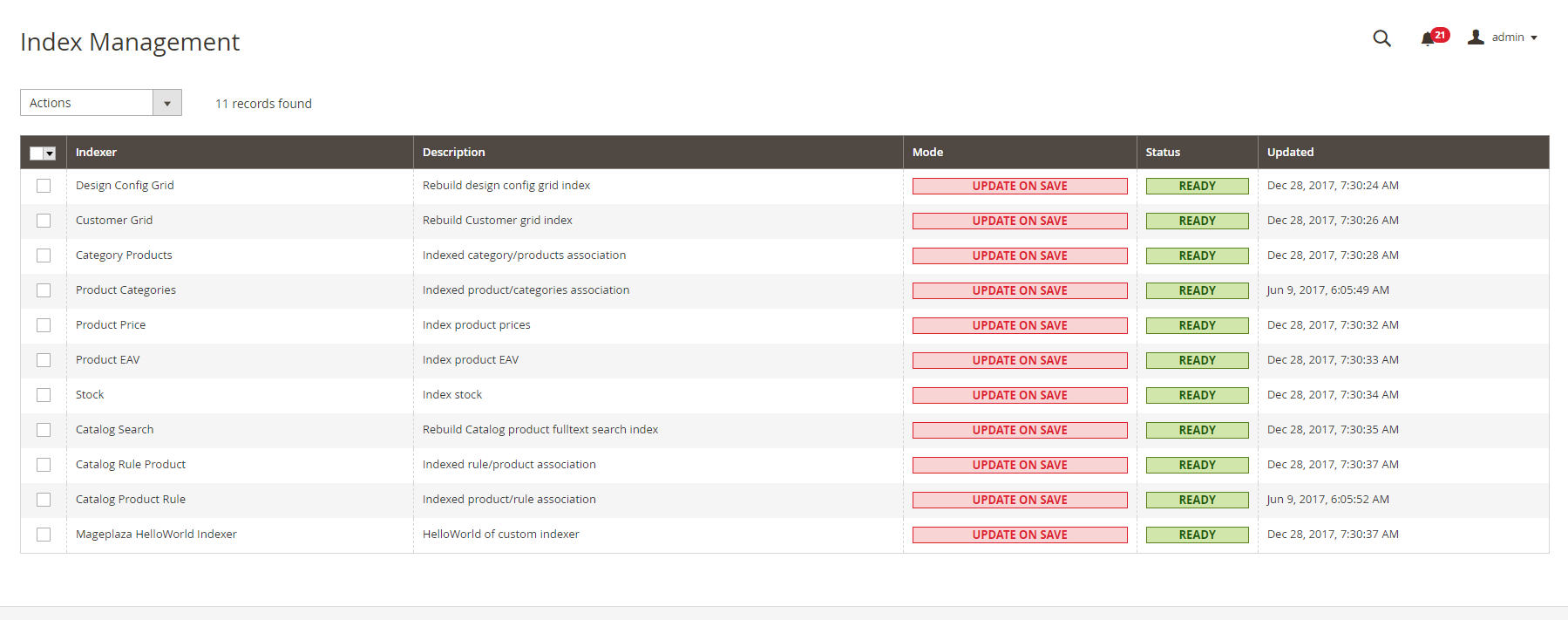Magento 2 Indexing & Reindex
In this article we will learn how to create an magento 2 indexing, magento 2 reindex. Indexer is an important feature in Magento 2.
In this article we will learn how to create an Indexer Reindex in Magento 2. Indexer is an important feature in Magento 2 Indexing. To understand how to create a Hello World module, you can read it here
We will use the example module Mageplaza_HelloWorld for this exercise. Please check our previous post to know how to create a sample module in Magento 2.
Indexing is how Magento transforms data such as products, categories, and so on, to improve the performance of your storefront. As data changes, the transformed data must be updated—or reindexed. Magento has a very sophisticated architecture that stores lots of merchant data (including catalog data, prices, users, stores, and so on) in many database tables. To optimize storefront performance, Magento accumulates data into special tables using indexers.
For example, suppose you change the price of an item from $8.99 to $6.99. Magento must reindex the price change to display it on your storefront.
Without indexing, Magento would have to calculate the price of every product on the fly—taking into account shopping cart price rules, bundle pricing, discounts, tier pricing, and so on. Loading the price for a product would take a long time, possibly resulting in cart abandonment.
Overview of creating indexer
Let’s start to create a custom indexer:
- Step 1: Create Indexer configuration file
- Step 2: Create Mview configuration file
- Step 3: Create Indexer class
- Step 4: Run a test
Create Indexer configuration file
This configuration file will define the indexer.
File app/code/Mageplaza/HelloWorld/etc/indexer.xml
<?xml version="1.0"?>
<config xmlns:xsi="http://www.w3.org/2001/XMLSchema-instance" xsi:noNamespaceSchemaLocation="urn:magento:framework:Indexer/etc/indexer.xsd">
<indexer id="mageplaza_helloworld_indexer" view_id="mageplaza_helloworld_indexer" class="Mageplaza\HelloWorld\Model\Indexer\Test">
<title translate="true">Mageplaza HelloWorld Indexer</title>
<description translate="true">HelloWorld of custom indexer</description>
</indexer>
</config>
In this file, we declare a new indexer process with the attribute:
- The id attribute is used to identify this indexer. You can call it when you want to check status, mode or reindex this indexer by command line.
- The
view_idis the id of view element which will be defined in themviewconfiguration file. - The class attribute is the name to the class which we process indexer method.
The simple Magento 2 indexing will have some child elements:
- The title element is used to define the Title of this when showing in indexer grid.
- The description element is used to define the Description of this when showing in indexer grid.
Create Mview configuration file
The mview.xml file is used to track database changes for a certain entity and running change handle (execute() method).
File: app/code/Mageplaza/HelloWorld/etc/mview.xml
<?xml version="1.0" encoding="UTF-8"?>
<config xmlns:xsi="http://www.w3.org/2001/XMLSchema-instance" xsi:noNamespaceSchemaLocation="urn:magento:framework:Mview/etc/mview.xsd">
<view id="mageplaza_helloworld_indexer" class="Mageplaza\HelloWorld\Model\Indexer\Test" group="indexer">
<subscriptions>
<table name="catalog_product_entity" entity_column="entity_id" />
</subscriptions>
</view>
</config>
In this file, we define a view element with an id attribute to call from indexer and a class which contain the execute() method. This method will run when the table in subscriptions is changed.
To declare the table, we use the table name and the column of this table which will be sent to the execute() method. In this example, we declare the table catalog_product_entity. So whenever one or more products is saved, the execute() method in class Mageplaza\HelloWorld\Model\Indexer\Test will be called.
Create Indexer class
Follow the indexer.xml and mview.xml above, we will define an Indexer class for both of them: Mageplaza\HelloWorld\Model\Indexer\Test
File: app/code/Mageplaza/HelloWorld/Model/Indexer/Test.php
<?php
namespace Mageplaza\HelloWorld\Model\Indexer;
class Test implements \Magento\Framework\Indexer\ActionInterface, \Magento\Framework\Mview\ActionInterface
{
/*
* Used by mview, allows process indexer in the "Update on schedule" mode
*/
public function execute($ids){
//code here!
}
/*
* Will take all of the data and reindex
* Will run when reindex via command line
*/
public function executeFull(){
//code here!
}
/*
* Works with a set of entity changed (may be massaction)
*/
public function executeList(array $ids){
//code here!
}
/*
* Works in runtime for a single entity using plugins
*/
public function executeRow($id){
//code here!
}
}
You can write the code to add data to your indexer table in the methods in Indexer class.
After this, please refresh the cache and go to System > Index Management from backend to see the result. It will show like this:



0 comments:
Post a Comment
Thanks